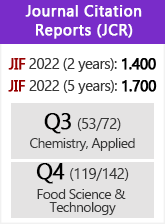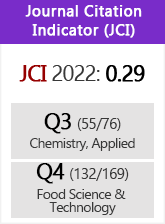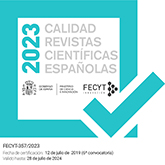Free radical scavenging and α-glucosidase inhibition, two potential mechanisms involved in the anti-diabetic activity of oleanolic acid
DOI:
https://doi.org/10.3989/gya.1237153Keywords:
Anti-diabetic activity, Antioxidant, α-glucosidase inhibitor, Olea europaea, Oleanolic acidAbstract
This work investigates the role of oleanolic acid (OA), isolated from the olive (Olea europaea L.) leaf, as a radical scavenger and inhibitor of the hydrolyzing enzymes of dietary carbohydrates. New evidence is provided showing that OA may capture 2,2’-azino-bis (3-ethylbenzothiazoline-6-sulphonic acid) and peroxyl radicals, and also exert a strong and non -competitive inhibition of α-glucosidase (IC50 10.11 ± 0.30 μM). The kinetic and spectrometric analyses performed indicate that OA interacts with this enzyme inside a hydrophobic pocket, through an endothermic and non spontaneous process of a hydrophobic nature. These are two possible mechanisms by which OA may facilitate a better control of post-prandial hyperglycaemia and oxidative stress, so contributing to preserving insulin signalling. Obesity, insulin resistance and Type 2 Diabetes Mellitus are considered the first pandemics of the 21st century. In this sense, OA might be used in future preventive and therapeutic strategies, as an ingredient in new drugs and functional foods.
Downloads
References
Albi T, Guinda A, Lanzón A. 2001. Procedimiento de obtención y determinación de ácidos terpénicos de la hoja de olivo (Olea europaea). Grasas Aceites 52, 275–278.
Ali H, Houghton PJ, Soumyanath A. 2006. ?-Amylase inhibitory activity of some Malaysian plants used to treat diabetes; with particular reference to Phyllanthus amarus. J. Ethnopharmacology 107, 449–455. http://dx.doi.org/10.1016/j.jep.2006.04.004 PMid:16678367
Ali MS, Jahangir M, Hussan SS, Choudhary MI. 2002. Inhibition of ?-glucosidase by oleanolic acid and its synthetic derivatives. Phytochemistry 60, 295–299. http://dx.doi.org/10.1016/S0031-9422(02)00104-8
Allouche Y, Warleta F, Campos M, Sánchez-Quesada C, Uceda M, Beltrán G, Gaforio JJ. 2011. Antioxidant, antiproliferative and pro-apoptotic capacities of pentacyclic triterpenes found in the skin of olives on MCF-7 human breast cancer cells and their effects on DNA damage. J. Agric. Food Chem. 59, 121–130. http://dx.doi.org/10.1021/jf102319y PMid:21142067
Assimopoulou AN, Zlatanos SN, Papageorgiu VP. 2005. Antioxidant activity of natural resins and bioactive triterpenes in oil substrates. Food Chem. 92, 721–727. http://dx.doi.org/10.1016/j.foodchem.2004.08.033
Brown BG, Zhao XQ, Chait A, Fischer LD, Cheung MC, Morse JS, Dowdy AA, Marino EK, Bolson EL, Alaupovic P, Frohlich J, Albers JJ. 2001. Simvastatin and niacin, antioxidant vitamins, or the combination for the prevention of coronary disease. N. Eng. J. Med. 345, 1583–1592. http://dx.doi.org/10.1056/NEJMoa011090 PMid:11757504
Castellano JM, Guinda A, Delgado T, Rada M, Cayuela JA. 2013. Biochemical basis of the antidiabetic activity of oleanolic acid and related pentacyclic triterpenes. Diabetes 62, 1791–1799. http://dx.doi.org/10.2337/db12-1215 PMid:23704520 PMCid:PMC3661625
Ceriello, A.; Testa, R. 2009. Antioxidant anti-inflammatory treatment in type 2 diabetes. Diabetes Care 32, S232–S236. http://dx.doi.org/10.2337/dc09-S316 PMid:19875557 PMCid:PMC2811469
Chen RJ, Liu X, Li PM, Zhang L, Zhao L and Zhang XL. 2010. Pharmacokinetic profiles of oleanolic acid formulations in healthy Chinese male volunteers. Chinese Pharmaceutical J. 45, 621–626.
Chowdhury SS, Islam MN, Jung HA, Choi JS. 2014. In vitro antidiabetic potential of the fruits of Crataegus pinnatifida. Res. Pharm. Sci. 9, 11–22. PMid:25598795 PMCid:PMC4292177
Dzubak P, Hajduch M, Vydra D, Hustova A, Kvasnica M, Biedermann D, Markova L, Urban M, Sarek J. 2006. Pharmacological activities of natural triterpenoids and their therapeuric implications. Nat. Prod. Rep. 23, 394–411. http://dx.doi.org/10.1039/b515312n PMid:16741586
Faridmoayer A, Scaman CH. 2005. Binding residues and catalytic domain of soluble Saccharomyces cerevisiae processing alpha-glucosidase I. Glycobiology 15, 1341–1348. http://dx.doi.org/10.1093/glycob/cwj009 PMid:16014748
Fujisawa T, Ikegami H, Inoue K, Kawabata Y, Ogihara T. 2005. Effect of two ?-glucosidase inhibitors, voglibose and acarbose, on postprandial hyperglycemia correlates with subjective abdominal symptoms. Metabolism 54, 387–390. http://dx.doi.org/10.1016/j.metabol.2004.10.004 PMid:15736118
Gabás-Rivera C, Martínez-Beamonte R, Ríos JL, Navarro MA, Surra JC, Arnal C, Rodríguez-Yoldi MJ, Osada J. 2013. Dietary oleanolic acid mediates circadian clock gene expression in liver independently of diet and animal model but requires apoliproprotein A1. J. Nutrit. Biochem. 21, 2100–2109. http://dx.doi.org/10.1016/j.jnutbio.2013.07.010 PMid:24231102
Guinda A, Albi T, Lanzón A. Procedure for the obtaining of oleanolic acid from the Olea europaea leaf. Spanish Patent 2001/2 160 553
Guinda A, Rada M, Delgado T, Gutiérrez-Adánez P, Castellano JM. 2010. Pentacyclic triterpenoids from olive fruit and leaf. J. Agric. Food Chem. 58, 9685–9691. http://dx.doi.org/10.1021/jf102039t PMid:20712364
Hou W, Li Y, Zhang Q, Wei X, Peng A, Chen L, Wei Y. 2009. Triterpene acids isolated from Lagerstroemia speciose leaves as ?-glucosidase inhibitors. Phytotherapy Res. 23, 614–618. http://dx.doi.org/10.1002/ptr.2661 PMid:19107840
Kang W, Song S, Gu X. 2012. ?-Glucosidase inhibitory in vitro and antidiabetic activity in vivo of Osmanthus fragans. J. Med. Plant Res. 6, 2850–2856.
Kang WY, Song YL, Zhang L. 2011. Alpha-glucosidase inhibitory and antioxidant properties and antidiabetic activity of Hypericum ascyron L. Med. Chem. Res. 20, 809–816. http://dx.doi.org/10.1007/s00044-010-9391-5
Khathi A, Serumula MR, Myburg RB, Van Heerden FR, Musabayane T. 2013. Effects of Sizigium aromaticum-derived triterpenes on postprandial blood glucose in streptozotocin-induced diabetic rats following carbohydrate challenge. PLOS ONE 8, e81632. http://dx.doi.org/10.1371/journal.pone.0081632 PMid:24278452 PMCid:PMC3838356
Komaki E, Yamaguchi S, Maru I, Kinoshita M, Kakehi K, Ohta Y, Tsukada Y. 2003. Identification of anti-?-amylase components from olive leaf extracts. Food Sci. Technol. Res. 9, 35–39. http://dx.doi.org/10.3136/fstr.9.35
Lacovicz JR. 2006. Principles of fluorescence spectroscopy (3rd edition). Springer. New York.
Liu J. 2005. Oleanolic acid and ursolic acid: Research perspectives. J. Ethnopharmacology 100, 92–94. http://dx.doi.org/10.1016/j.jep.2005.05.024 PMid:15994040
Lowell BB, Shulman GI. 2005. Mitochondrial dysfunction and type 2 diabetes. Science 307, 384–387. http://dx.doi.org/10.1126/science.1104343 PMid:15662004
Minich DM, Bland JS, Katke J, Darlang G, Hall A, Lerman RH, Lamb J, Carroll B, Trypp M. 2007. Clinical safety and efficacy of NG440: a novel combination of rho iso-alpha acids from hops, rosemary, and oleanolic acid for inflammatory conditions. Can. J. Physiol. Pharmacol. 85, 872–883. http://dx.doi.org/10.1139/Y07-055 PMid:18066133
Prior RL, Hoang H, Gu L, Wu X, Bacchiocca M, Howard L, Hampsch-Woodill M, Huang D, Ou B, Jacob R. 2003. Assay for hydrophilic and lipophilic antioxidant capacity (oxygen radical absorbance capacity (ORACFL)) of plasma and other biological and food samples. J. Agric. Food Chem. 51, 3273–3279. http://dx.doi.org/10.1021/jf0262256 PMid:12744654
Quagliaro L, Piconi L, Assalone R, Martinelli L, Motz E, Ceriello A. 2003. Intermittent high glucose enhances apoptosis related to oxidative stress in human umbilical vein endothelial cells. Diabetes 52, 2795–2804. http://dx.doi.org/10.2337/diabetes.52.11.2795 PMid:14578299
Rada M, Castellano JM, Perona J, Guinda A. 2015. GC-FID determination and pharmacokinetic studies of oleanolic acid in human serum. Biomed. Chromatog. 29, 1687–1692. http://dx.doi.org/10.1002/bmc.3480 PMid:25943913
Re R, Pellegrini N, Proteggente A, Pannala A, Yang M, Rice-Evans C. 1999. Antioxidant activity applying and improved ABTS radical cation decolorization assay. Free Rad. Biol. Med. 26, 1231–1237. http://dx.doi.org/10.1016/S0891-5849(98)00315-3
Schiekofer S, Andrassy M, Chen J, Rudofsky G, Schneider J, Wendt T, Stefan N, Humpert P, Fritche A, Stumvoll M, Schleicher E, Häring H-U, Nawroth PP, Bierhaus A. 2003. Acute hyperglycemia causes intracellular formation of CML and activation of ras, p42/44 MAPK, and nuclear factor ?B in PBMCs. Diabetes 52, 621–633. http://dx.doi.org/10.2337/diabetes.52.3.621 PMid:12606501
Sharma O, Bhat TK. 2009. DPPH antioxidant assay revisited. Food Chem. 13, 1202–1205. http://dx.doi.org/10.1016/j.foodchem.2008.08.008
Song M, Hang TJ, Wang Y, Jiang L, Wu XL, Zhang Z, Shen J, Zhang Y. 2006. Determination of oleanolic acid in human plasma and study of its pharmacokinetics in Chinese healthy male volunteers by HPLC tandem mass spectrometry. J. Pharmaceut. Biomed. Anal. 40, 190–196. http://dx.doi.org/10.1016/j.jpba.2005.06.034 PMid:16126358
Wang X, Li Y-L, Wu H, Liu J-Z, Hu J-X, Liao N, Peng J, Cao P-P, Liang X, Hai C-X. 2011. Antidiabetic effect of oleanolic acid: A promising use of a traditional pharmacological agent. Phytother. Res. 25, 1031–1040. http://dx.doi.org/10.1002/ptr.3385 PMid:21254272
Wang X, Ye X-L, Liu R, Chen H-L, Bai H, Liang X, Zhang X-D, Wang Z, Li W-L, Hai C-X. 2010. Antioxidant activities of oleanolic acid in vitro: Possible role of Nrf2 and MAP kinases. Chemico-Biological Interactions 184, 328–337. http://dx.doi.org/10.1016/j.cbi.2010.01.034 PMid:20100471
Watson JD. 2014. Type 2 diabetes as a redox disease. The Lancet 383, 841–843. http://dx.doi.org/10.1016/S0140-6736(13)62365-X
Xu LZ, Wan ZX. 1980. The effect of oleanolic acid on acute hepatitis (70 cases). Human Medicine 7, 50–52.
Yan J, Zhang G, Pan J, Wang Y. 2014. ?-Glucosidase inhibition by luteolin: Kinetic, interactions and molecular docking. Int. J. Biol. Macromol. 64, 213–223. http://dx.doi.org/10.1016/j.ijbiomac.2013.12.007 PMid:24333230
Yang ZG, Li HR, Wang LY, Li YH, Lu SG, Wen XF, Wang J, Daikonoya A, Itanaka S. 2007. Triterpenoids from Hippophae rhamnoides L. and their nitric oxide production-inhibitory and DPPH radical-scavenging activities. Chem. Pharm. Bull. 55, 15–18. http://dx.doi.org/10.1248/cpb.55.15
Yin M-C, Chan K-C. 2007. Nonenzymatic antioxidative and antiglycative effects of oleanolic acid and ursolic acid. J. Agric. Food Chem. 55, 7177–7181. http://dx.doi.org/10.1021/jf071242m PMid:17658830
Published
How to Cite
Issue
Section
License
Copyright (c) 2016 Consejo Superior de Investigaciones Científicas (CSIC)

This work is licensed under a Creative Commons Attribution 4.0 International License.
© CSIC. Manuscripts published in both the printed and online versions of this Journal are the property of Consejo Superior de Investigaciones Científicas, and quoting this source is a requirement for any partial or full reproduction.All contents of this electronic edition, except where otherwise noted, are distributed under a “Creative Commons Attribution 4.0 International” (CC BY 4.0) License. You may read here the basic information and the legal text of the license. The indication of the CC BY 4.0 License must be expressly stated in this way when necessary.
Self-archiving in repositories, personal webpages or similar, of any version other than the published by the Editor, is not allowed.
















